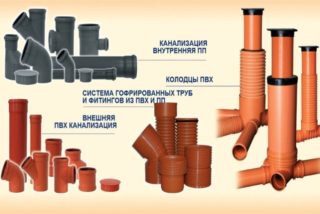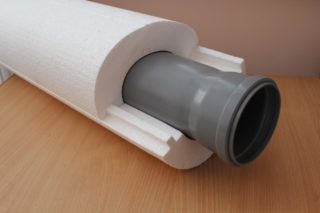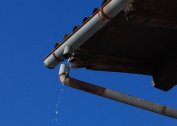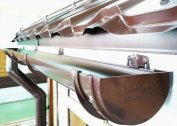According to SNIPs, cast-iron sewer lines change once every forty years. However, if blockages, leaks often occur, an unpleasant odor seeps all the time, the system must be replaced earlier. Following the technology, you can do it yourself without hiring professionals.
Material selection for a new pipeline
 For sewer communications use polymer, ceramic and metal pipes. Ceramic products are expensive, they are practically not used for apartment buildings. Rather, they are intended for use in industrial facilities due to their resistance to aggressive environments.
For sewer communications use polymer, ceramic and metal pipes. Ceramic products are expensive, they are practically not used for apartment buildings. Rather, they are intended for use in industrial facilities due to their resistance to aggressive environments.
Steel pipe products are cheaper, more durable and resistant to high temperatures. But at the same time, they quickly rust, which is why they are rarely used for installation in apartments.
Cast iron pipes are more expensive than steel pipes, but are more resistant to rust. They are suitable for laying communication networks in apartments. The disadvantages are a decrease in throughput over time, installation difficulties due to the large mass of the product and the mandatory availability of the necessary special equipment for installation. The advantages of cast iron are high strength and long life.
The most common option is a polymer pipeline. Pipe and fitting elements are available in two types: from polypropylene or polyvinyl chloride.
Advantages of Polymer Highways
Plastic pipes have many advantages:
- low weight, due to which they are easy to mount;
- lack of special equipment during installation;
- resistance to rust.
The smooth surface of the plastic prevents cork from forming and does not overgrow with time. In addition, polymer products look aesthetically pleasing, and their cost is much lower than parts made of other materials.
The disadvantages of plastic pipes and their elimination
Polymeric products have one significant minus - noise. For sound insulation, the following methods are used:
- The pipes are insulated from the walls with the help of damper clamps, and from the floors - with polyurethane foam slabs.
- To eliminate the unpleasant gurgling of water in the pipeline, polyurethane or foam insulators are used. The riser and trunk are wrapped.
- Foamed polyethylene helps to remove the sound wave. But this material does not last long and may begin to sour and even stick if the room is hot.
The best option is to purchase special pipes with a sound-absorbing effect. They are made of plastic with the addition of mineral powder. Such material in sound insulation is not inferior to cast iron products. The disadvantages of such pipes are high cost and short life (not more than twenty years).
Pipe replacement at the expense of the management company
According to the law, the obligation to repair and replace part of the communications in the apartment is assigned to the housing company and is carried out at its expense. The process of repair and replacement of sewage is regulated by:
- The rules for maintaining common house property in apartment buildings.
- Standards and rules for the operation of the housing stock.
- Guidelines for the maintenance and repair of the housing stock.
The risers operated by several apartments of one entrance belong to joint ownership and the housing and communal services should be responsible for their replacement. Branches from the riser to the first connection point are also considered to be common property.Maintenance and repair of all other pipelines in the apartment is carried out at the expense of the owners.
Tools and materials
 In addition to pipe sections, other sewage elements will be required: adapters from plastic to cast iron, expansion joints, revisions, crosses, couplings, bends, tees, rubber cuffs for joints. To process and seal the joints, cement, silicone sealant and liquid detergent will be required.
In addition to pipe sections, other sewage elements will be required: adapters from plastic to cast iron, expansion joints, revisions, crosses, couplings, bends, tees, rubber cuffs for joints. To process and seal the joints, cement, silicone sealant and liquid detergent will be required.
If you decide to change the pipeline yourself, you need a set of tools. It includes:
- grinder or pipe cutter (used to cut pipes, dismantle the riser from cast iron);
- hammer;
- bubble level;
- chisel;
- roulette;
- plumb.
Additionally, goggles and a respirator may be required to protect against metal splinters and dust.
Preparatory work
 Before carrying out installation and dismantling work, you need to draw a drawing of the wiring of the sewer network in the apartment. It will help to calculate how many and which pipes, fittings, fasteners will be required, and determine the total cost. The price of pipe segments from plastic starts at 22 rubles per linear meter.
Before carrying out installation and dismantling work, you need to draw a drawing of the wiring of the sewer network in the apartment. It will help to calculate how many and which pipes, fittings, fasteners will be required, and determine the total cost. The price of pipe segments from plastic starts at 22 rubles per linear meter.
When drawing up the scheme, it is necessary to take into account all sanitary equipment, their location (kitchen, bathroom, toilet) and how they will be connected to the exits of the highway.
When replacing an external sewage system in a private house, you need to find a scheme for laying the old pipeline in the ground in order to know where to open the soil. If the damaged area is located under the asphalt, so as not to spoil the coating, use the trenchless method of laying a new highway.
Residents of high-rise buildings on the upper floors need only coordinate work with the management company and the housing department. Those living on the lower floors need to warn their neighbors so that they do not use plumbing fixtures for some time.
The last stage of preparation is the disconnection of water supply pipes and the release of the workplace from foreign objects.
Installation Steps
 When replacing pipes of cast-iron sewage with plastic, the first thing you need to do is disassemble the old communications. After that, proceed as follows:
When replacing pipes of cast-iron sewage with plastic, the first thing you need to do is disassemble the old communications. After that, proceed as follows:
- The pipe of the required length is cut with a pipe cutter or grinder, then it is chamfered and cleaned with sandpaper. Install the adapter from cast iron to plastic in the pipe section.
- The resulting structure is mounted on the remainder of the pipe protruding from the ceiling, until it stops. If work is carried out on the top floor, install a stub. The permissible gap between the elements should not exceed 5 millimeters.
- Mounting elements for the riser are installed on the wall. If the ceilings are at a height of more than 3 meters, put four clamps. For familiar ceilings 2.5 meters high, three fixtures are enough.
- Before final installation, cuffs and gaskets are inserted into pipes and fittings. Joints are coated with soap to facilitate assembly. After all parts are mounted, the riser is fixed to the fasteners.
Upon completion of the installation, a test check of the pipeline is performed. To do this, a large amount of water is poured into the sewer line. In the absence of leaks, a new system can be used.
Sewer pipes made of plastic can be connected by the bell method. With this method, the end of the pipe is inserted into the expanded part (bell) of the other. The tightness of the joint is ensured by a rubber gasket in the shape of a ring.
Possible mistakes
If the old riser does not flow, it is still better to change it. Moreover, you can convince employees of the management company of the need for this action and assign work to them. Otherwise, there is a risk of a breakthrough due to the pressure difference in the transition between cast iron and plastic.
When installing the sewage system, it is worth considering the following points:
- It is recommended to remove the old cast-iron tee, which was used to connect the toilet bowl and sewer pipe of a smaller diameter, or a direct outlet, and replace it with a plastic product. Modern elements take up less space and save the volume of the bathroom.
- Do not be afraid to pack the layout of water and sewer pipes under the tiles. The anti-corrosion structure of plastic pipes and high-quality rubber seals at the joints eliminate the risk of breakthrough.
- It is important to fix the trunk in an open area with a length of more than a meter with special fasteners. Clogging may form in the pipes and will have to be cleaned. Loose connections simply break apart.
Another mistake is to save on materials and work. If you have never held a tool in your hands, replacing the sewer system yourself will be difficult and troublesome. Easier to call professionals.
Prices for works on replacing sewer pipes in a house or apartment start from 200 rubles per linear meter. It matters the experience and qualifications of the master, the cost of materials, the complexity of the work. Using someone else's work, you will save time and, in the event of a breakthrough, you can bring the masters to justice.



